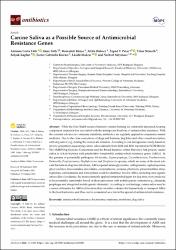| dc.contributor.author | Toth, Adrienn Greta | |
| dc.contributor.author | Toth, İmre | |
| dc.contributor.author | Rozsa, Bernadett | |
| dc.contributor.author | Dubecz, Attila | |
| dc.contributor.author | Patai, Arpad, V | |
| dc.contributor.author | Nemeth, Tibor | |
| dc.contributor.author | Kaplan, Selçuk | |
| dc.date.accessioned | 2023-05-06T17:23:40Z | |
| dc.date.available | 2023-05-06T17:23:40Z | |
| dc.date.issued | 2022 | |
| dc.identifier.issn | 2079-6382 | |
| dc.identifier.uri | https://doi.org/10.3390/antibiotics11111490 | |
| dc.identifier.uri | https://hdl.handle.net/20.500.11776/12240 | |
| dc.description.abstract | While the One Health issues of intensive animal farming are commonly discussed, keeping companion animals is less associated with the interspecies headway of antimicrobial resistance. With the constant advance in veterinary standards, antibiotics are regularly applied in companion animal medicine. Due to the close coexistence of dogs and humans, dog bites and other casual encounters with dog saliva (e.g., licking the owner) are common. According to our metagenome study, based on 26 new generation sequencing canine saliva datasets from 2020 and 2021 reposited in NCBI SRA by The 10,000 Dog Genome Consortium and the Broad Institute within Darwin's Ark project, canine saliva is rich in bacteria with predictably transferable antimicrobial resistance genes (ARGs). In the genome of potentially pathogenic Bacteroides, Capnocytophaga, Corynebacterium, Fusobacterium, Pasteurella, Porphyromonas, Staphylococcus and Streptococcus species, which are some of the most relevant bacteria in dog bite infections, ARGs against aminoglycosides, carbapenems, cephalosporins, glycylcyclines, lincosamides, macrolides, oxazolidinone, penams, phenicols, pleuromutilins, streptogramins, sulfonamides and tetracyclines could be identified. Several ARGs, including ones against amoxicillin-clavulanate, the most commonly applied antimicrobial agent for dog bites, were predicted to be potentially transferable based on their association with mobile genetic elements (e.g., plasmids, prophages and integrated mobile genetic elements). According to our findings, canine saliva may be a source of transfer for ARG-rich bacteria that can either colonize the human body or transport ARGs to the host bacteriota, and thus can be considered as a risk in the spread of antimicrobial resistance. | en_US |
| dc.description.sponsorship | European Union's Horizon 2020 research and innovation program [874735] | en_US |
| dc.description.sponsorship | The research was supported by the European Union's Horizon 2020 research and innovation program under Grant Agreement No. 874735 (VEO). | en_US |
| dc.language.iso | eng | en_US |
| dc.publisher | Mdpi | en_US |
| dc.identifier.doi | 10.3390/antibiotics11111490 | |
| dc.rights | info:eu-repo/semantics/openAccess | en_US |
| dc.subject | antimicrobial resistance | en_US |
| dc.subject | bacteriome | en_US |
| dc.subject | resistome | en_US |
| dc.subject | mobilome | en_US |
| dc.subject | dog saliva | en_US |
| dc.subject | Dog Bites | en_US |
| dc.subject | Prescribing Patterns | en_US |
| dc.subject | Microbiology | en_US |
| dc.subject | Prescription | en_US |
| dc.subject | Population | en_US |
| dc.subject | Management | en_US |
| dc.subject | Reservoirs | en_US |
| dc.subject | Infection | en_US |
| dc.subject | Trends | en_US |
| dc.subject | Cats | en_US |
| dc.title | Canine Saliva as a Possible Source of Antimicrobial Resistance Genes | en_US |
| dc.type | article | en_US |
| dc.relation.ispartof | Antibiotics-Basel | en_US |
| dc.department | Fakülteler, Ziraat Fakültesi, Tarımsal Biyoteknoloji Bölümü | en_US |
| dc.authorid | KAPLAN, SELCUK/0000-0003-1101-2296 | |
| dc.authorid | Solymosi, Norbert/0000-0003-1783-2041 | |
| dc.identifier.volume | 11 | en_US |
| dc.identifier.issue | 11 | en_US |
| dc.institutionauthor | Kaplan, Selçuk | |
| dc.relation.publicationcategory | Makale - Uluslararası Hakemli Dergi - Kurum Öğretim Elemanı | en_US |
| dc.authorwosid | Kaplan, Selçuk/ABA-2299-2020 | |
| dc.identifier.wos | WOS:000880709100001 | en_US |
| dc.identifier.scopus | 2-s2.0-85141752555 | en_US |
| dc.identifier.pmid | 36358144 | en_US |



















